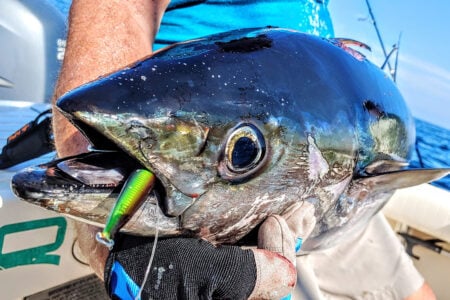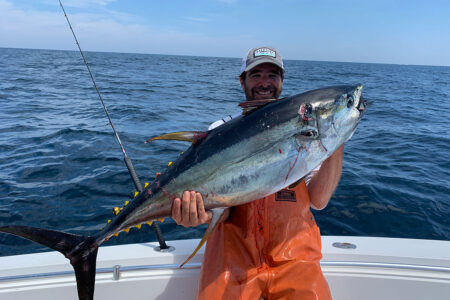
Head offshore for the biggest thrill Northeast fishing has to offer!
Set your feet on the deck as the boat comes off plane, pinch your line against the cork, open the bail, pick a target, load the rod back and follow through as you cast. See your popper land in the rippled remnants of thrashing tuna. Flip your bail closed, reel tight to the popper, sweep the rod tip once, twice, three times. BANG. Watch in amazement as a pelagic sea monster erupts from the blue water swallowing your lure and nearly ripping the rod out of your hands.
Calm your hooting and hollering and hold on for the first long run. Keep the line away from the hull and enjoy the sound of your drag! If all goes as planned, you will have it close to the boat in just a few minutes. As the fish battles to survive, its final spirals underneath your hull will let you know when victory is near. Keep your wits about you, mind other lines, boats, pots, etc…and never celebrate prematurely. These fish will test your tackle to its limit. The fight is not over until you pull that high speed torpedo over the side. But when you do, oh man, there’s just nothing like it.
Catching a fish on a topwater lure is maybe the biggest rush in fishing, whether it’s heavyweight pelagics or a neighborhood largemouth. It’s a crazy feeling to be able to entice a wild animal with a lure so delicious looking that they are willing to blast out of their own environment and into ours; it’s just so fun to watch! My own topwater journey came from catching trout and panfish on dry flies as a kid. I thought it was amazing that fish would venture to the surface and even jump out of the water to eat a bug. When I started to catch striped bass on poppers and spooks, I particularly loved watching a small pack of them fight over the lure, slapping it with their tails. I practically drove myself crazy trying to find topwater bites; it was all I could think about. And, it often still is!
However, I never imagined that fishing could give me the feeling that popping for tuna does. It truly is the ultimate rush. Seeing 100-plus pound fish in the wild with your own eyes is exciting in itself, getting to cast lures at them is flat out intense and getting one to eat your lure is nothing short of exhilarating. And it just so happens that yellowfin tuna in New England and Mid-Atlantic waters are often very eager to eat a properly presented popper.

Look For Life
Any offshore angler will tell you that finding ocean life is, almost always, the most important part of your day. The presence of whales, porpoise and birds is clear evidence of forage in the area and therefore a likely place for tuna to feed as well. Yellowfin tuna in our corner of the mighty Atlantic tend to follow the warm water eddies, pockets and rivers that shoot out of or break away from the Gulf Stream some 200-plus miles from the dock. This requires a more intentional search than the strategy to locate their bluefin’d counterparts, who often swim within just a few miles of our shores.
If you are able to find water in the 73-plus degree range within 40 miles of shore you may have a shot at yellowfin. If yellowfin are your goal you should learn to read temp charts and plan your trips around what these useful scans tell you. It is no surprise that you will often find lots of life on the major temp breaks as they act as edge habitat where forage species for all levels of the food chain end up gathering. The Northeast canyons are the most famous of Atlantic tuna grounds, where all the Atlantic species can be found, feeding on incredible swaths of bait caught in the massive currents of the continental shelf. I have seen some incredible numbers of yellowfin both on the mid-shore grounds and in the canyons.
As with any fish, they enter different modes of activity, behavior and feeding styles. In general, I have found that yellowfin are more apt to eat a topwater lure than bluefin. I am unsure if it is because their warm water habitat gives them a bit of an energy boost, or if they are just instinctually more aggressive than bluefin when it comes to artificial lures. As my good friend and experienced offshore angler Earl Evans put it, “Yellowfin are hungry and have low inhibitions.” It is not uncommon to see them blast 10 feet out of the water with a popper in their mouth like Jaws inhaling a seal pup. Other times they will be spooky, leader shy and cruise right past your popper. I will never forget watching acres of very picky yellowfin gently sipping micro bait at dawn near Atlantis just a few hours after watching a school of them turn hundreds of yards of ocean into a frothing hot tub of food chain destruction.
Throwing poppers as a blind cast searching tool is an excellent tactic, as well as popping through active feeds as the tuna slash the surface; you can even trigger a bite when they are in that surface slow rolling mode, eating only micro bait. I think the only time when throwing a popper is a bad idea is when there is intense bird activity (specifically shearwaters). The only thing worse than hooking a shearwater accidentally while trying to hook a tuna is maybe hooking yourself or the person who owns the boat.

Choose Your Weapon
I have used quite a few different styles, brands and sizes of poppers for yellowfin and had success on many (see my recommendations in Pick a Popper). I think casting accuracy, strength in construction and a clean white belly color are the characteristics I look for most in a popper (the white belly really pops out if you are a tuna looking up towards the surface). Unless the stock hardware already passes as ‘diesel’ I will swap out hooks to Owner ST-66 4X and connect them with Owner Ultra Split rings. While the yellowfin are sometimes poo-pooed for not fighting as hard as bluefin or bigeye, they will absolutely put your tackle to the ultimate test. It’s always best to over-prepare as it is certainly possible that you might hook one far larger than you anticipated.
I like to use a 7-1/2- or 8-foot rod for this application, a casting rating between 150 grams and 200 grams is good. A high-quality reel is a must, get the best one you can afford. “There are a few good choices for topwater yellowfin, and they’re all in the 14K size range, the Daiwa BGMQ is a reliable budget-friendly option or you can bump up to the Saltiga,” said Max Finch at Fisherman’s World in Norwalk, CT, adding “For Shimano, the Saragosa is a great choice or you can ‘go all the way’ and opt for the Stella.”
Van Staal’s Earl Evans added, “The VSX2 250 is the go-to for us, with 36.5 inches per turn, it’s plenty fast enough to work a popper and it has big cranking power capable of keeping the rod bent and keeping pressure on the fish, too.”
Fluorocarbon leader is a must; you will have days when its relative ‘invisibility’ in the water will make a big difference with picky fish. I connect my braid to my leader with an FG knot and my leader to lure using a heavy-duty barrel swivel with an Ultra Split Ring threaded onto the ‘lure end’ of the rig, I tie this on using a Palomar knot. It’s crucial to connect a popper (or really any tuna lure with a swivel as any twisting can cause the lure to perform poorly in the water and even break off under pressure). And if you’re wondering how this connection works, you just need a pair of split ring pliers to change lures.
I have heard all kinds of advice on leader length and materials for popping tuna. What has worked best for me is a leader a bit longer than the length of fish I intend to catch as this provides ample abrasion resistance from mouth to tail during the fight. This typically ends up being approximately 10 feet. No need for extra-long leaders like I would recommend for stealth purposes such as when vertical jigging.

Welcome The Wilderness
It is good to be fully-confident in your gear when heading offshore as it is very common for the excitement of the moment to overshadow any normal tackle maintenance tendencies you may have while fishing. It is hard to think about wind knots, leader rub and dull hooks while you are preparing to cast at enormous tuna blowing up piles of bait in the open ocean. But, mark my words, if there is a weakness in your rig, they will find it and they will expose it.
I encourage everyone to venture offshore when the opportunity arises. Just like the backcountry woods and those distant mountains far away from town, the offshore fishing grounds are a wilderness, too. It’s a guarantee that you will not know what you are going to encounter each trip. It is an ever-evolving and truly wild habitat.
It’s that beautiful unknown that keeps me up at night all tuna season long. Where are the yellowfin? What are they eating? Why did my leader snap last trip? Can I improve my setup? Do the yellowfin like this presentation more? It’s all-consuming and terribly addicting! All this before even saying a word about how delicious they are to eat! I get excited about catching pretty much anything but when I see that yellow color circling under the boat after an exciting eat and powerful fight I get super excited. My fishing buddies will tell you that I pretty much lose all control of my vocal cords and hoot and holler and laugh like a child.
That’s what it’s all about!
| PICK A POPPER |
| There are endless options out there when it comes to poppers. Here are a few readily available and trusted options.
The Madd Mantis Cherry Popper has been my go-to offering for any and all topwater tuna opportunities. It provides an excellent balance of size, long and accurate casts, medium to large size face (which provides nice pop and bubbles, without digging in too deep, or stalling out) and is available naked, or rigged with stout trebles and split rings.  I also really like the Yo-Zuri Mag Poppers. They are available in multiple sizes and colors. Again, I am a believer in white belly, the back color is irrelevant to me. They also come rigged with nice hooks, but they will begin to bend out after multiple fish, so I always swap upon purchase.  The Nomad Design Chug Norris may have the best lure name in the game…it is an excellent offering as well. If you want big noise, this popper makes it! It casts well and is rigged adequately. I do find that it pops and digs so aggressively that it sometimes will stall out, but overall it’s a great option.  From here you can dive as deep as you’d like into the world of offshore plug builders and even shop internationally for lures designed for GT and other powerful exotics. I think the most important things to look for are thru-wire construction and is a solid stout rigging. |



